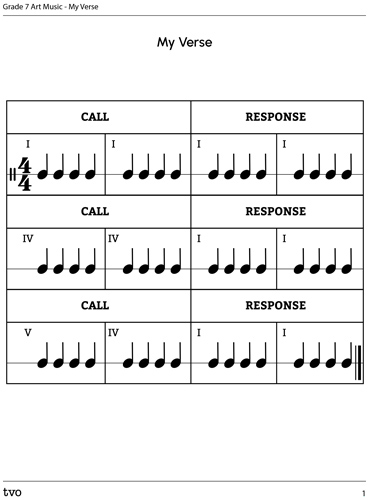Minds On
Today’s vocabulary
Several notes, often three or four, played simultaneously, usually containing a root, third, and fifth. Chords of three notes are often called triads. For example, a G-major chord (triad) is made up of the notes G (root), B (third), and D (fifth).
- A lead-and-follow activity, sometimes also called question and answer.
- A song or rhythmic pattern that consists of a “call” section sung or played by a leader and a “response” section sung or played by an individual or group. The call (question) and response (answer) are different phrases (not echoes). Calls and responses are often improvised. (Rhythm example: The teacher claps “ta, ta, ti-ti, ta” and the student claps a response “ti-ti, ti-ti, ta, ta”. Instrumental example: The teacher and student create a call and response using different notes from a pentatonic scale on a xylophone). It is a form that is common in many musical traditions. Explore also echo singing.
Let’s get started!

Explore Bessie Smith’s song, “Backwater Blues”.
The song was written about the Mississippi River flood of 1927, which was one of the worst natural disasters in the history of the United States.
As you explore, consider the following questions:
- What is your initial impression of the music?
- How are the lyrics organized? Do you notice any patterns?
When possible, use specific examples from the song to support your answers.
Record your thoughts digitally, orally, or in print.
Access this recording of Bessie Smith’s “Backwater Blues”.
Bessie Smith’s “Backwater Blues”
Bessie Smith’s “Backwater Blues”
When it rained five days and the sky turned dark as night
When it rained five days and the sky turned dark as night
Then trouble's takin' place in the lowlands at night
I woke up this mornin', can't even get out of my door
I woke up this mornin', can't even get out of my door
There's enough trouble to make a poor girl wonder where she wanna go
Then they rowed a little boat about five miles 'cross the pond
Then they rowed a little boat about five miles 'cross the pond
I packed all my clothes, throwed 'em in and they rowed me along
When it thunders and lightnin', and the wind begins to blow
When it thunders and lightnin', and the wind begins to blow
There's thousands of people, ain't got no place to go
And I went and stood up on some high old lonesome hill
And I went and stood up on some high old lonesome hill
Then looked down on the house where I used to live
Backwater blues done called me to pack my things and go
Backwater blues done called me to pack my things and go
'Cause my house fell down and I can't live there no more
Mmm, I can't move no more
Mmm, I can't move no more
There ain't no place for a poor old girl to go
– Bessie Smith
Action
Get ready, get set…
Task one: Blues form

Every piece of music has an overall plan or structure. This is called the musical form. For example, Bessie Smith’s “Backwater Blues” follows a 12-bar blues form.
There are specific components to a 12-bar blues song. These often include:
- a 12-bar chord progression
- lyrics that follow what’s known as an AAB pattern
- call and response
Chord progression
The 12 bar blues is a chord progression that lasts for 12 bars, or measures.
The chord progression commonly uses three chords, which are based on the first (written as I), fourth (IV), and fifth (V) notes of a seven-note scale.
Press ‘Scale degrees and chords’ to learn more about how these work in music.
It’s important to note that chords are written using Roman numerals (I, II, III, IV, V, and so on).
Chord: Several notes, often three or four, played simultaneously, usually containing a root, third, and fifth. Chords of three notes are often called triads. For example, a G-major chord (triad) is made up of the notes G (root), B (third), and D (fifth). Chords are usually described with roman numerals – for example, I for the chord on the first degree of the scale, or tonic; V for the chord on the fifth degree of the scale, or dominant; IV for the chord on the fourth degree of the scale, or subdominant. A commonly used chord progression is therefore written and described as I-IV-V-I.
Each Roman numeral represents the scale degree on which a chord is created.
This is an example of a C major scale. Each scale degree is labelled with a number.

Scale degree 1 is the first note of a scale, scale degree 2 is the second, scale degree 3 is the third, scale degree 4 is the fourth, and so on. Scale degree numbers are the same for every scale.
Here’s the C major scale with triads (chords with three notes) on scale degrees 1, 4, and 5.

The I chord consists of the notes C E G.
The IV chord consists of the notes F A C.
The V chord consists of the notes G B D.
Here’s an example of the most common 12-bar blues progression.
Student Tips
Tip
Read the table from left to right, starting at the top row and working down.

There are three lines of music with four bars, or measures, in each line. 12 bars in total. In each bar, there are four slashes, which represent the number of beats. The Blues are often played in 4/4 time, so there are 4 beats per bar and 16 beats in each line. There is a Roman numeral above each bar, which represents the scale degree on which the chord is created. The chord numbers are as follows: I, I, I, I, IV, IV, I, I, V, V, I, I.
The 12 bars are split into three groups of four bars.
- Measures 1-4: the 1 chord for four bars.
- Measures 5-8: the 4 chord for two bars, followed by the 1 chord for two bars.
- Measures 9-12: the 5 chord for one bar, the 4 chord for one bar, and the 1 chord for two bars.

Teacher B: There are common variations to the 12-bar blues. For example, sometimes there is a turnaround in the last two bars that act as a transition to the next blues verse.
Teacher A: For this to happen, the 12-bar blues will end on a 5 chord instead of a 1 chord.
Explore 12-bar blues under the following link: Song Maker(Opens in a new window)
Task two: Blues lyrics
Musical form can describe the overall structure of a song and a smaller section like a verse.
For example, the lyrics of a 12-bar blues song often follow an AAB pattern.
An AAB verse consists of a line (A), a repeated line (A), and a new line (B). The third line often completes the thought of the first two lines.
Take for example a verse from “Backwater Blues” in AAB form.
(A) When it thunders and lightnin’, and the wind begins to blow
(A) When it thunders and lightnin’, and the wind begins to blow
(B) There’s thousands of people, ain’t got no place to go
Press ‘AAB lyric pattern’ to learn more about how AAB verses work.
AAB verses often follow a problem-problem-solution pattern or a question-question-answer pattern. Take for example this AAB verse from Willie Nelson’s “Rainy Day Blues”:
(A) “Well it’s cloudy in the morning, gonna be raining in the afternoon
(A) Cloudy in the morning and it’s gonna be raining in the afternoon
(B) If you don’t like this rainy weather you better pack your bags and move”
This verse follows a problem-problem-solution pattern. The problem (A) is that it’s a cloudy morning and it’s going to rain in the afternoon.
The solution (B) is to gather up one’s belongings and go somewhere else.

Putting the lyrics and music together
When the lyrics are added to the 12-bar blues form, they are arranged as a call and response.
Explore the following AAB verse from Bessie Smith’s “Backwater Blues.”
Notice how each line is divided into two parts: the call and the response.
The singer sings during the ‘Call’ section and rests (does not sing) during the ‘Response’ section while the instrumentalists play.
Access this recording of Bessie Smith’s “Backwater Blues.”
Bessie Smith’s “Backwater Blues”
Next, explore how the verse fits the 12-bar blues form.

The table shows the AAB verse from Bessie Smith’s “Backwater Blues” fits into the 12-bar blues form. This table splits the 12 bars into 3 lines of 4 measures. Each line is divided into a) the call and b) the response. The call and the response each have 2 measures.
Part 1
Call: The lyrics “When it thunders and lightnin’, and the wind begins to blow” are above the first two measures. The first measure depicts the Roman numeral I in the top left corner and the symbol for 4/4 time followed by a four-note chord. The second measure depicts the Roman numeral IV followed by four note-chord.
Response: The third measure depicts the Roman numeral I in top left corner and a four-note chord. The fourth measure depicts the Roman numeral I in the top left corner and a four-note chord.
Part 2
Call: The lyrics “When it thunders and lightnin’, and the wind begins to blow” are above the fifth and sixth measures. The fifth measure depicts the Roman numeral IV in the top left corner and a four-note chord. The sixth measure also depicts the Roman numeral IV in the top left corner and a four-note chord.
Response: The seventh measure depicts the Roman numeral I in the top left corner and a four-note chord. The eighth measure also depicts the Roman numeral I in the top left corner and a four-note chord.
Part 3
Call: The lyrics “There’s thousands of people, ain’t no got no place to go” are above the ninth and tenth measures. The ninth measure depicts the Roman numeral V in the top left corner and a four-note chord. The tenth measure depicts the Roman numeral IV in the top corner and a four-note chord.
Response: The eleventh measure depicts the Roman numeral I in the top corner and a four-note chord. The twelfth and final measure depicts the Roman numeral I and four-note chord.
The vocal line, or sung melody, is the ‘call’ and the musicians play an instrumental ‘response’.
- A: Lyrics are sung as the Call during bars 1 and 2. The Response is played during bars 3 and 4.
- A: Lyrics are sung as the Call during bars 5 and 6. The Response is played during bars 7 and 8.
- B: Lyrics are sung as the Call during bars 9 and 10. The Response is played during bars 11 and 12.
Press '12-bar blues variations' to learn more about variations on the the form.
Variations on the 12-bar blues
Did you notice that bar 2 is a ‘IV’ instead of a ‘I’? While it’s common for the first four bars to remain on ‘I’, it’s not a hard and fast rule. There are many variations of the 12-bar blues, but all of them contain the same basic elements.

The table shows a standard 12-bar blues progression. The 12 measures are split into 3 lines of four measures. Each measure has a Roman numeral, which refers to the chord. The chords appear in the following order: 1, 1, 1, 1, 4, 4, 1, 1, 5, 4, 1, 1. Each line is divided into two parts: the Call and the Response. The first two measures of each line are the Call. The last two measures of each line are the Response.
Question time!
How many bars of music does the singer actually sing for the verse?
Press ‘Check’ to access the answer to this question.
The vocal melody or vocal line takes up about 6 bars of the 12-bar form.
Go!
It’s your turn to put it all together.
Add an AAB verse to the 12-bar blues form.
Select one of the following options.
Option A: Use a verse in AAB form you have already created in another lesson.
Option B: Use the following example below called “The Cold Winter Blues”.
(A) I’ve got the cold winter blues, I just want some sun
(A) I’ve got the cold winter blues, I just want some sun
(B) Oh, hey it’s snowing, I’m gonna go have some fun
Record your verse in the graphic organizer provided or using another method of your choice.
Complete the My Verse in your notebook or using the following printable document. If you would like, you can use speech-to-text or audio recording tools to record your thoughts.
The table shows a standard 12-bar blues progression. The 12 measures are split into 3 lines of four measures. Each measure has a Roman numeral, which refers to the chord. The chords appear in the following order: 1, 1, 1, 1, 4, 4, 1, 1, 5, 4, 1, 1. Each line is divided into two parts. The first two measures of each line are the Call. The last two measures of each line are the Response.
Consolidation
Putting it all together
Planning a performance

Return to your AAB verse in the Action section.
Describe how you would perform the verse to a backing track. Consider the following questions:
- In which bars would you sing each line of the verse?
- How many bars of music would you sing in total?
Reference specific bar numbers to support your description.
If possible, speak or sing your lyrics to the following backing track.
A vocal melody has been added for you. You may also create your own vocal melody.
Repeat the 12-bar progression as many times as you like! (This backing track has a turnaround.)

Press the following link to access a Chrome Lab version of this song:
Music Lab(Opens in a new window)
Portfolio
Review your learning
Use the following questions to reflect on your learning. Record your responses digitally, orally, or in print.
Consider adding your work to your portfolio.
Use the following questions to reflect on your learning.
Using musical terms, how would you describe the characteristics of the 12-bar blues form?
Consider the following musical terms:
- chords
- progression
- roman numerals
- turnaround
- AAB lyric form
- call and response
Why is it important to know how a song is organized when reading and creating music?
Reflection
As you read the following descriptions, select the one that best describes your current understanding of the learning in this activity. Press the corresponding button once you have made your choice.
I feel...
Now, expand on your ideas by recording your thoughts using a voice recorder, speech-to-text, or writing tool.
When you review your notes on this learning activity later, reflect on whether you would select a different description based on your further review of the material in this learning activity.
